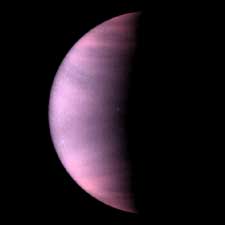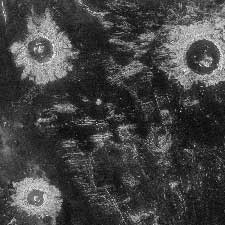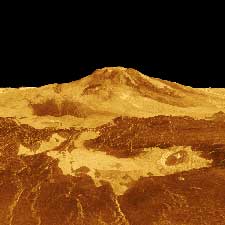Venus
Venus is the second planet from the Sun and it is the brightest object in the night sky (if you don’t count the Moon). It is another of the planets that can be seen with the naked eye.
It is so bright that it can even be seen in daylight if you know exactly where to look.
The planet is often called “Earth’s sister” because both the Earth and Venus are so similar in size and mass (Venus is only slightly smaller than Earth).
Interestingly, Venus doesn’t spin in the same direction as the other planets in the solar system. If all the other planets are considered to spin forwards, Venus is the only planet to spin backwards. This means that the Sun will always rise in the west and set in the east on Venus.
Early studies of Venus
The first document that refers to the planet is The Venus tablet of Ammisaduqa which was written by the ancient Babylonians and is thought to date back to 1581 BC. They noted how bright the object appeared in the night sky and referred to the planet as “the queen of the sky”.
The Greeks later believed that Venus was in fact two separate stars when viewed during the day and night and referred to them as Phosphorus and Hesperus. The Morning Star and the Evening Star were the names commonly given to Venus.
The Romans continued in the belief that there were “morning” and “evening” stars and used the Roman translations of the previous Greek names which led to the names “Lucifer” and “Vesper” to describe the planet. Later the name Venus was used which was the Roman goddess of love and beauty.
Venus is the only planet that is named after a female and it is commonly associated with femininity.
Venus Facts
Venus is very similar in size to the Earth (the diameter of Venus is only roughly 600 kilometres less than Earth) and it is the second closest planet to the Sun at approximately 108 million kilometres away.
Although Venus is not the closest planet to the Sun, it is the hottest. The reason for this is the dense atmosphere that is found on Venus. It is so dense that the warming greenhouse gases cannot escape through the atmosphere and this leads to a surface temperature of around 480 degrees Celsius.
The planet's’ atmosphere is made up of largely carbon dioxide (CO2) and nitrogen (N2), with some clouds that contain sulphuric acid (H2SO4). The surface pressure is over 90 times greater than it is on Earth.
Unsurprisingly there has been no sign of life due to the harshness of the surface of Venus and it is extremely unlikely that any life will be found in future studies.
Venus is known as a terrestrial planet which is rocky and made up from large numbers of volcanic eruptions leaving a pitted, rocky surface. Amazingly there are nearly 200 volcanoes on Venus that are over 100 kilometres wide. There is no evidence of water due to the extremely high surface temperatures – any water would dry immediately. In fact, the surface temperature is so hot that it would melt lead.
There have been recent studies which suggest that billions of years ago, Venus may have had an atmosphere that was somewhat similar to the atmosphere on the Earth, but over millions of years greenhouse gases have built up and the increase in temperature would have evaporated any water that may have existed billions of years ago.
Venus completes a full orbit around the Sun every 225 days, so the Venusian calendar is made up of a year lasting only 225 days.
The time it takes Venus to compete a full rotation is the longest of the major planets at 243 days. This means a single day on Venus would last for 243 Earth days!
The NASA Mariner 2 was the first spacecraft to take readings from Venus in 1962, but the first spacecraft to land on the surface of the Venus was the USSR’s Venera 3 which landed in 1966.
Figures and Statistics
| Venus | Earth | Ratio (Planet to Earth) | |
| Rotation period - (hours) | 5832.6 | 23.9345 | 243.69 |
| Length of day - (hours) | 2802 | 24.00 | 116.75 |
| Length of year (earth days) | 583.92 | 365 | 0.676 |
| One complete orbit takes (earth days) | 224.701 | 365.256 | 0.615 |
| Radius (km) | 6051.8 | 6378.1 | 0.9499 |
| Mass (1024 kg) | 4.8685 | 5.9726 | 0.815 |
| Volume (1011 km3) | 9.28 | 108.321 | 0.857 |
| Density (kg/m3) | 5204 | 5514 | 0.944 |
| Distance from Earth - Min (106km) | 38.2 | - | - |
| Distance from Earth - Max - (106km) | 261.0 | - | - |
| Average distance from Sun (106km) | 108.209 | 149.6 | 0.723 |
| Orbital radius (106km) | 107.5-109 | 147-152 | 0.731 - 0.717 |
| Orbital velocity (average - km/s) | 35.02 | 29.78 | 1.176 |
| Rotational velocity (km/h) | 6.52 | 1674.4 | 0.004 |
| Surface gravity (m/s2) | 8.87 | 9.81 | 0.904 |
| Surface temp - Average (K) | 767 | 330 | 2.324 |
| Axial tilt (degrees) | 177.36 | 23.44 | 7.567 |
| Number of natural satellites (moons) | 0 | 1 | - |
-
Notes on the above figures:
- Orbits are invariably elliptical in nature. The average distance from the sun that appears above is also known as a 'semi-major axis', which is the mean (average) radius of the elliptical orbit.
- Axial tilt is also known as 'obliquity to orbit' and is the angle of rotation of the body itself with an imaginary line drawn through both poles, relative to its plane of orbit.
- Radius figures quoted are equatorial measurements. As most bodies exhibit 'oblateness' - that is to say that they appear slightly squashed - the radius from the centre to the poles would invariably be shorter.
- The Kelvin temperature scale is used for all temperature measurements above. 0K is equivalent to -273.15°C (degrees Celsius). To convert from K to C, simply subtract this figure from the Kelvin temperature given.
- Use of 'Index Notation' for very large numbers as above can be explained as follows; 106 = 10 x 10 x 10 x 10 x 10 x 10, or 1,000,000. For example, if you see a number that appears as 6x1011 then that number written in full would be 6 x 10 x 10 x 10 x 10 x 10 x 10 x 10 x 10 x 10 x 10 x 10 - or 600,000,000,000. Index notation allows us to write very big (or very small) numbers down far more concisely.


